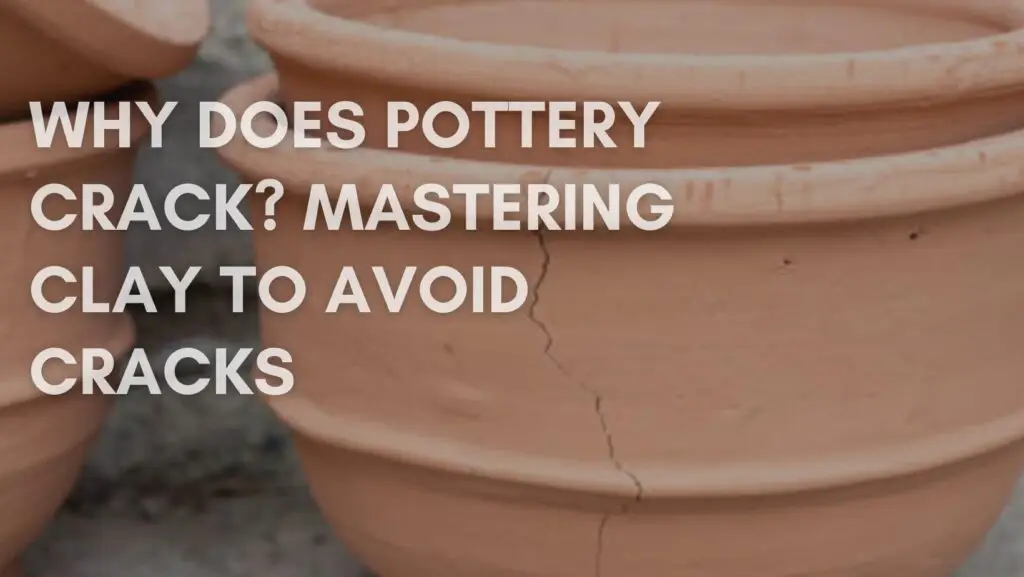1. Introduction: Cracks in Pottery Are Normal for Beginners
Why Does Pottery Crack? For anyone who’s just beginning their pottery journey, encountering cracks in your creations can feel frustrating. You spend hours crafting a beautiful piece, only to find it split or fractured after drying or firing. But here’s the truth: cracking is a normal part of the learning process, especially for first-timers.
Pottery is both an art and a science. It requires an understanding of how clay behaves, dries, and transforms in the kiln. While there are many reasons why pottery cracks, one of the most overlooked yet critical causes is uneven kneading of clay.
In this guide, we’ll explore why cracks occur, with a special focus on the importance of proper kneading techniques. We’ll also provide practical tips to minimize cracks and encourage you to embrace the imperfections that come with learning.
2. What Causes Cracks in Pottery?
Cracks in pottery can result from several factors, including:
- Uneven kneading of clay
- Improper drying techniques
- Variations in thickness
- Inconsistent firing temperatures
Each of these issues disrupts the structural integrity of the clay, causing stress points that lead to cracks. Among these, uneven kneading is a root cause often overlooked, especially by beginners who are eager to jump into shaping and throwing.
3. Understanding Uneven Kneading: The Core Issue
What Is Kneading Clay?
Kneading, also called wedging, is the process of preparing clay before shaping it. It involves working the clay to:
- Remove air bubbles
- Ensure consistency in moisture content
- Align the clay particles for better workability
Without proper kneading, the clay can develop weak spots, leading to cracking during drying or firing.
Why Uneven Kneading Leads to Cracks
Why does pottery crack- due to uneven kneading? Uneven kneading occurs when the clay is not thoroughly worked to create uniformity. This can result in:
- Air Pockets: Trapped air expands in the kiln, causing cracks or explosions.
- Moisture Imbalance: Uneven moisture levels create stress points as the clay dries.
- Weak Bonding: Poorly mixed clay particles lead to structural weaknesses.
For instance, imagine making a pot with clay that feels smooth on the surface but hides air bubbles and dry patches inside. These hidden flaws often surface as cracks after firing.
Symptoms of Poorly Kneaded Clay
- The clay feels lumpy or sticky in certain areas.
- You notice cracks forming during shaping or drying.
- Pieces break apart during firing, often with jagged edges.
Step-by-Step Guide to Proper Kneading
Here’s how to knead clay effectively to prevent cracks:
- Flatten the Clay: Start with a manageable amount of clay and flatten it into a thick slab.
- Cut and Stack: Use a wire tool to cut the slab in half, then stack the pieces. This aligns the clay layers.
- Roll and Press: Roll the clay into a cylinder, then press and fold it in a spiral motion.
- Repeat: Repeat the process 10–15 times or until the clay feels smooth, uniform, and free of air bubbles.
- Check for Consistency: Cut the clay to inspect for air pockets or uneven moisture.
Tip: If you’re a beginner, spend extra time kneading. It’s better to over-knead than to risk uneven clay.
4. Other Common Causes of Cracks
Drying Issues
Drying clay too quickly or unevenly can create cracks. Always dry pieces in a controlled environment, avoiding direct sunlight or excessive airflow.
Thickness Variations
Uneven thickness in your pottery creates stress points. Keep walls and bases consistent to minimize cracking.
Overfiring or Underfiring
Firing at incorrect temperatures can cause thermal shock, leading to cracks. Always use the appropriate firing schedule for your clay body.
5. How to Minimize Cracks in Pottery
- Prioritize Proper Kneading: Spend enough time kneading clay to eliminate air pockets and moisture imbalances.
- Control Drying: Cover pieces with plastic to slow drying and ensure even moisture loss.
- Maintain Consistent Thickness: Use simple tools like wooden dowels to ensure uniform thickness.
- Use Clay Appropriate for Beginners: Some clay types are more forgiving and less prone to cracking.
- Inspect Pieces Before Firing: Check for hidden cracks or weak spots before placing them in the kiln.
6. Why Cracks Can Still Happen to Beginners (And That’s Okay)
Even with the best techniques, cracks can still occur, especially for first-timers. This is because:
- Clay is a natural material with inherent imperfections.
- Beginners may unintentionally skip critical steps like thorough kneading or controlled drying.
Cracks are part of the learning process and should be seen as opportunities to improve. Over time, as you gain experience, you’ll develop a better feel for clay and reduce the likelihood of cracking.
Remember: Pottery is about progress, not perfection. Each crack is a stepping stone toward mastering the art.
7. Conclusion: Practice Makes Perfect
Cracks in pottery are inevitable for beginners, but they don’t have to be discouraging. By focusing on proper techniques—especially thorough and even kneading—you can significantly reduce the chances of cracks and create stronger, more beautiful pieces.
Pottery is as much about embracing imperfections as it is about achieving mastery. So, keep experimenting, keep learning, and remember that every cracked piece tells a story of growth and perseverance.

